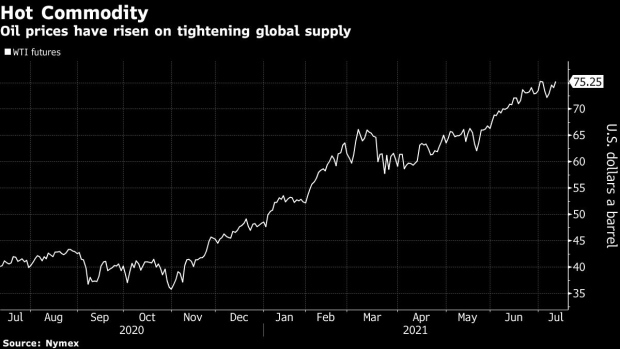Jul 13, 2021
Oil advances to 33-month high on warning about supply crunch
, Bloomberg News
Oil rose to the highest price in more than 2 1/2 years as prospects of an imminent flood of crude exports from Iran and other major producers waned while the International Energy Agency warned of a deepening supply crunch.
Futures in New York advanced 1.6 per cent to close at US$75.25 a barrel on Tuesday, the highest settlement since October 2018. Crude supplies are set to “tighten significantly” amid a deadlock among members of the OPEC+ alliance, the IEA said in a report. Meanwhile, a stalemate over whether to revive the Iranian nuclear deal has reduced the threat of a deluge of the nation’s crude onto global markets.
“The supply-deficit story is reasserting as the primary driver,” said Ed Moya, senior market analyst at Oanda Corp.

Futures clung to gains after the industry-funded American Petroleum Institute was said to report U.S. crude supplies fell 4.08 million barrels last week and inventories declined at the nation’s biggest storage hub at Cushing, Oklahoma.
Oil prices have surged more than 50 per cent this year as vaccination rollouts accelerated the reopening of economies, boosting fuel consumption. OPEC and allied crude producers have supported prices by taking a gradual approach to resurrecting shuttered supplies.
The oil consortium has been deadlocked on increasing production as the dispute between the United Arab Emirates and Saudi Arabia persists. Both countries have locked in stable crude output for next month.
“Even if OPEC decides to raise output in August, that crude will not reach refineries until after the August peak-demand period will be over,” Ed Morse, head of commodities research at Citigroup Inc., said in an email.
Nuclear talks between world powers and Iran are unlikely to resume until after the Islamic Republic installs its new president next month, all but eliminating the chances of an early revival of the accord that could trigger a jump in Iranian oil exports.
Prices
- West Texas Intermediate for August delivery traded at US$75.14 a barrel at 4:47 p.m. in after-market trading after settling at US$75.25 on the New York Mercantile Exchange.
- Brent for September settlement advanced US$1.33 to end session at US$76.49 on the ICE Futures Europe exchange.
Still, the demand rebound is imperiled by the swift spread of the COVID-19 delta variant, which is forcing restrictions on work and mobility as it spreads through a largely unvaccinated Southeast Asia.
Indonesia, Southeast Asia’s biggest economy, is being wracked by a particularly brutal wave of the pandemic, prompting restrictions in the industrial heartland of Java and the tourist enclave of Bali. Malaysia is still in the midst of a nationwide lockdown, while Thailand has just stepped up limitations.
The API also reported gasoline supplies fell 1.54 million barrels last week and distillate inventories rose 3.7 million barrels.
Other market news:
- American drillers have restored less than 20 per cent of the oilfield services jobs lost due to the pandemic with companies favoring investor returns over boosting output, according to a trade group.
- Limetree Bay Refining LLC filed for Chapter 11 bankruptcy in Houston on Monday after the U.S. Environmental Protection Agency closed its Caribbean oil refinery.
--With assistance from Grant Smith, Sharon Cho and Sheela Tobben.





